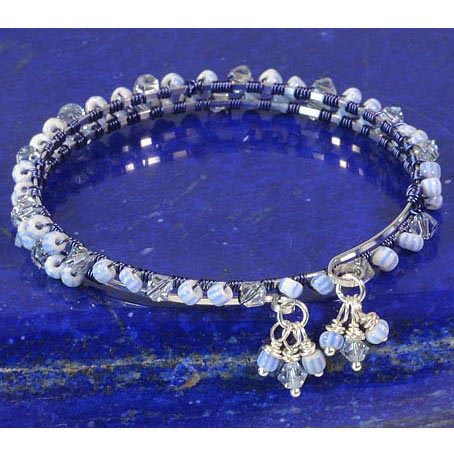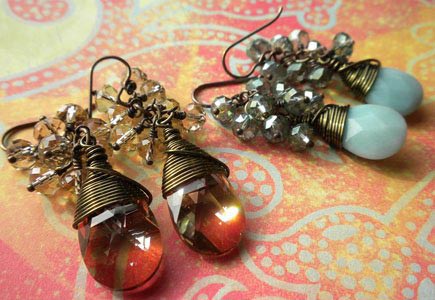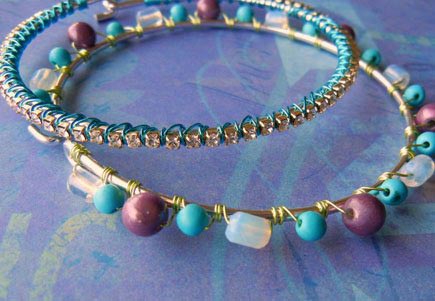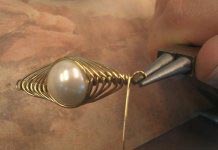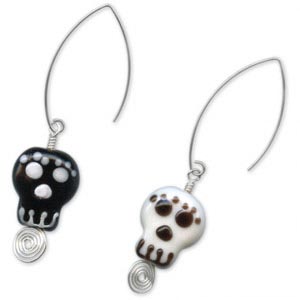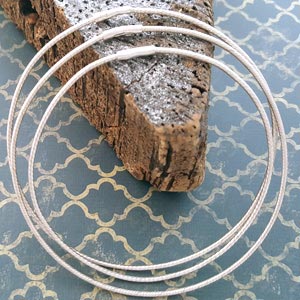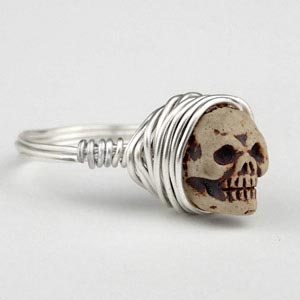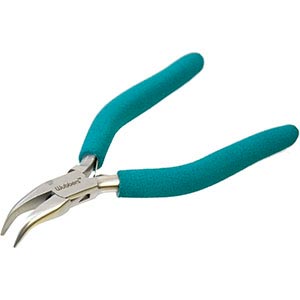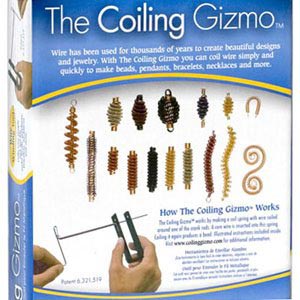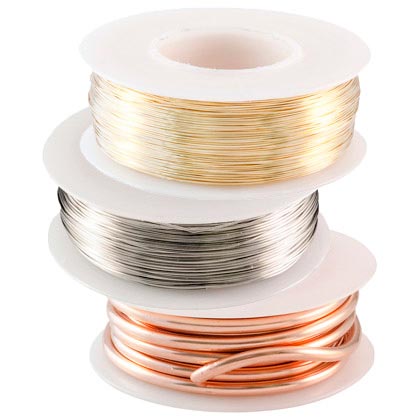Wire Jewelry 101
Jewelry making wire gives you endless choices in creativity! Still, it's easier to get started once you know a few basic tips and terms that will help you determine what type of wire to use for your jewelry projects. Learn about different shapes, gauges, and materials of craft wire.
Find full tutorials, jewelry projects, and supplies too.
Wire Gauges
The gauge of a piece of wire is a measurement of its width (diameter). Gauge is often abbreviated as "ga", thus 20 gauge = 20ga. There are two main gauge systems used to determine wire size for crafters and artisans. American Wire Gauge is typically (but not always) the way jewelry wire is measured in the United States and Canada. Standard Wire Gauge (SWG) is typically (but not always) the measurement system used in Great Britain. Most other European countries measure wire size in millimeters.
Gauge numbers work the opposite of how you'd expect. The larger the gauge, the smaller the wire's diameter. This is because the numbers were originally determined from how many times a piece of wire had to pass through a draw plate before it was done being sized. The more times through the plate, the thinner the wire.
| Wire Gauge Conversion Chart Sizes listed are AWG (American Wire Gauge) | ||
| Wire Gauge | Inches | Millimeters |
| 6 | 0.162 | 4.11 |
| 8 | 0.129 | 3.27 |
| 9 | 0.114 | 2.91 |
| 10 | 0.102 | 2.56 |
| 12 | 0.081 | 2.05 |
| 14 | 0.064 | 1.63 |
| 15 | 0.057 | 1.45 |
| 16 | 0.051 | 1.30 |
| 17 | 0.045 | 1.14 |
| 18 | 0.040 | 1.02 |
| 19 | 0.036 | 0.914 |
| 20 | 0.032 | 0.813 |
| 21 | 0.029 | 0.737 |
| 22 | 0.025 | 0.635 |
| 24 | 0.020 | 0.508 |
| 25 | 0.018 | 0.455 |
| 26 | 0.016 | 0.406 |
| 28 | 0.013 | 0.320 |
| 30 | 0.010 | 0.254 |
| 32 | 0.008 | 0.203 |
Common Jewelry Uses of Wire by Gauge (AWG):
- 32 gauge wire for jewelry making is extremely fine (thin). It can be used for intricate wire work like wire weaving, bead crochet, Viking knit, and fine coils. It can even be used like sewing thread, to "stitch" beads and embellishments onto leather bracelets or metal blanks.
- 32 gauge bezel wire can be used for setting cabochon stones, and is also great for creating no-solder resin bezels in custom shapes and sizes.
- 30 gauge wire and 28 gauge wireare slightly thicker (and stiffer), and used for the same types of wire work as 32 gauge wire.
- 26 gauge jewelry wireis very fine. 26-gauge wire is popular for wire weaving and Viking knit, and can be used like stiff sewing thread, to "stitch" beads onto leather bracelets or metal blanks. It's a popular size of wire to use with pearls and tiny gemstone beads, which normally have smaller holes than other beads.
- 24 gauge jewelry wire is a good all-purpose wire diameter. 24-gauge wire is fine enough to fit through most gemstone beads, and is durable enough to make good wire-wrapped loops.
- 22 gauge jewelry wire is a good general-purpose wire gauge. It's a little too thick to fit through most pearl beads or small gemstone beads, but has excellent durability and workability for most other general jewelry purposes.
- 21 gauge is a popular size for many wire jewelry projects that call for square wire.
- 20 gauge wire is a good all-purpose, versatile wire size, thin enough to use with most beads. If you use half-hard wire (or you work-harden dead-soft wire), then 20-gauge wire is also sturdy enough to hold its shape for making handmade chain, ear wires, eye pins, jump rings, and lightweight clasps. When work-hardened, 20ga works well for bracelet and necklace wire.
- 18 gauge jewelry wire is used for making sturdy clasps, jump rings and other findings. Solid (not plated or filled) 18-gauge wire can be used to make rivets. 18ga makes good Eastern-style ear wires too, or can be pulled through a drawplate to make springy 20ga or 21ga ear wires, the traditional size for ear wires in the United States.
- 16 gauge jewelry wire works well for making sturdy clasps and findings, and is a good weight for necklace and bracelet wire. Solid (not plated or filled) wire 16ga wire is used to make rivets. Depending on the metal, 16ga gauge may be difficult to bend.
- 14 gauge wire is primarily used to create thick, extra-strong components such as clasps, rings, cuff bracelets and bangle bracelets. It can also be used to create frames for resin and mixed media projects, as well as structural support for many styles of jewelry. Solid 14ga wire can be used to make rivets. Depending on the metal, this gauge may be difficult to bend. 14 gauge wire is often only available in dead soft temper.
- 12 gauge jewelry wire is fairly heavy. It's popular for rings, neck collars, bangle bracelets and cuff bracelets. It's stiff enough that you'll want good-quality jewelry tools when working with it, but it's not too hard to shape. For soft wire such as copper, you may need to work-harden the wire to make sure bracelets and rings don't bend out of shape. Sometimes the process of forming your jewelry into the proper shape, work-hardens it enough. For other designs you may need to hammer-texture them or use a wire whacker on your finished design. It is usually only available in dead soft, and may require heavy-duty wire cutters or a jeweler's saw.
- 10 gauge is a heavy-gauge jewelry wire. It's a great thickness for making wire bangle bracelets, but it's too stiff for some crafters' hands to work with. It is usually only available in dead soft, and generally requires heavy-duty jewelry tools for both cutting and shaping.
Wire Shapes
The shape of a wire refers to what you see when you look at a cross section of it (i.e. the cut end).
| Round wire is the most common wire shape, and is the standard shape used in most wire working. | |
| Square wire is sometimes chosen for purely aesthetic reasons, since the corners of square wire lend a different look to finished jewelry. It also has a practical advantage when you want to place several pieces of wire flush against each other. The flat sides of square wire will lay flush in a way that round wire can't. This makes square wire preferable in banding designs. Also, you can use a pin vise to twist square wire, for a sparkling effect. | |
| Half round wire is typically used to connect several adjacent pieces of square wire. The flat side of the half-round wire is placed against the square wires, and the rounded side remains exposed in the finished design. This is called banding. | |
| Twisted (aka fancy) wire is used to provide textural and aesthetic qualities to wire work. It can be formed from round wires or square wires. You can buy ready-made twisted wire, or make your own with a pin vise or Beadalon® wire twister. When making your own, keep in mind that your finished fancy wire will be a thicker gauge than the individual wires you start with. |
Wire Metals
You have many choices regarding what metals your jewelry making wire is made of, including sterling silver, fine silver, gold-filled, copper, brass, nickel silver, 316L stainless steel and more.. Options include solid metal wire, filled (overlay) wire, plated wire, enamel-coated colored wire, and anodized wire.
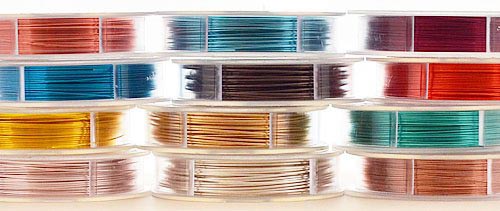
- Solid Precious Metal Wire is the number one choice for high-end jewelry and craft designs. Options include .999 fine silver, Argentium and sterling silver wire. Argentium is a tarnish-resistant alloy, which means you and/or the end user will spend less time polishing! Find out more: "What are precious metals?"
- Silver Fill & Gold Fill wires are also called overlay. They're created by using heat and pressure to apply a thick layer of precious metal to a base of less costly metal (brass). Use these when you're making upper-end designs but need something more economical than solid precious metal wire. Fill/overlay is typically considered precious metal, despite not being solid, because the precious metal surface is hundreds of times thicker than a plating (see illustration).
- Solid Base Metal Wire works great for making finished artisan jewelry. It's also popular as a practice material and way to create prototypes for precious metal designs. Bare copper wire is especially popular for all 3 of these uses. Other options include stainless steel, nickel silver (aka German silver), brass, and bronze wire. Which base metal you choose will largely be based on what color you want your design to be, but learning about the properties of different metals can also help you decide. Find out more about the properties of base metals.
- German-style Silver Plate & Gold Plate Wire give you colors that match precious metal components without the added cost. The disadvantage of plated wire is that when it's over-manipulated, the plating can crack and chip, revealing the base metal underneath. As a result, plated wire is best used for designs that do not require extensive bending and wrapping.
- Enamel-coated wire offers a rainbow of permanent colors that won't chip or crack. Artistic Wire® is one of the leading brands. It's made from copper wire covered with a permanent colored enamel coating. The silver plated colors have a layer of pure silver between the copper wire and the final, permanent enamel layer. This adds a brilliant, high shine to silver plated colors. Artistic Wire is considered dead soft. Although the finish will not chip or crack, take care to avoid scraping through the colored layer. Many wire workers use nylon jaw pliers, or coat their tool tips with Tool Magic.
- Anodized wire offers bright colors that are created in a chemical bath. Because the colors are not plated, they are more durable than plated colors. However, care should be taken to avoid scratching through the anodized layer. Many wire workers use nylon jaw pliers, or coat their tool tips with Tool Magic.
- Memory wire offers several sizes of wire coils that retain their round or oval shape (like the classic springy Slinky toy). It works great for making beaded wine charms, rings, multistrand bracelets and chokers. Flat memory wire works well as a foundation for lashing beads onto it.
- Bullion (aka French wire) is a delicate, tightly coiled wire that's used to cover and protect the end loops of bead cord on necklaces and bracelets. It's available in fine, medium, heavy, and extra heavy. Choose from sterling silver and base metal options.
For more on how to choose which type of wire to use, see Dead Soft vs. Half Hard Wire...
Dead Soft vs. Half Hard Wire
Sometimes you have the option of choosing "dead soft" wire or "half hard" wire. As the names suggest, dead soft wire is extremely easy to bend, even with your hands. Half hard wire offers some resistance when you try to bend it. The advantage of dead soft wire is that it's easy to shape. The advantage of half hard wire is that once you've shaped it, it retains its shape better.
The more you work with a piece of wire, the more it will naturally harden. This is called work hardening the wire. When you've achieved the shape you want, you may be able to hammer the wire to harden it. Using a ball-peen hammer will give the wire a dappled texture, using a chasing hammer can nicely flatten it, and carefully using a nylon or rawhide hammer can harden it without altering the shape.
Whether to buy half hard or dead soft is often a matter of personal preference. Nevertheless, here are a few general guidelines to help you get started:
- Dead soft works well to make flowing curves and spirals.
- Half hard creates good sharp angles.
- Dead soft is typically used for wire weaving and wire wrapping, including wrapped cabochons and "sculpted" wire jewelry.
- Half hard is good for making components that need to hold their shape (ear wires, clasps, jump rings, necklace foundations, bracelet forms, etc.).
- Gold-fill and silver-fill wire are generally harder than dead soft sterling silver or fine silver wire, and are often closer to half hard.
Scale of Hardness for Beadalon® Brand Wire
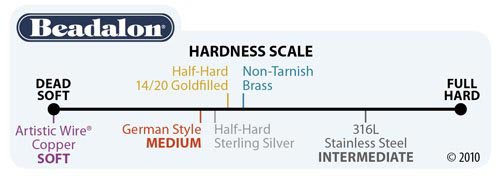
When in doubt, choose dead soft wire. Wire becomes more stiff and brittle the more you work with it. This is called work hardening. If you accidentally buy wire that is too malleable for your intended purpose, you can work harden it yourself with a nylon-head hammer, a Wire Whacker, a draw plate, or a tumbler. To re-soften wire that's too stiff for your intended purpose, you need to anneal it (heat it, then gradually cool it) - a more complicated process.
Tutorials & Projects
Buy Supplies
Ready to make custom jewelry with wire?- Cup Burs or Wire Rounders are cup-shaped files, sometimes battery operated, that quickly and neatly round the ends of cut wire. If you make your own ear wires, these are worth their weight in gold.
- Drawplates are excellent for helping you turn dead soft or half-hard wire into super springy wire that is excellent for making your own ear wires, hoops, and other custom-shaped wire earring forms.
- More supplies and tools to help you get started:
Our Bead Blog
-
Rubber Tubing Necklace and Memory Wire Bracelet Set
Mar 21st 2025Designed by: Guest Designer Deb Floros Suggested Supplies 1 #61-622-02 2mm Rubber Cord, Bulk,
-
Mixed Metal Bracelet/Necklace
Mar 21st 2025Designed by: Guest Designer Deb Floros Suggested Supplies 1 #40-415-01-4 Gold Plated Curb Chai
-
Simple Teardrop Earrings
Mar 14th 2025Designed by: Guest Designer Deb Floros Suggested Supplies 2 #06-000-11-20 PRESTIGE 6000 Tip-Dr


